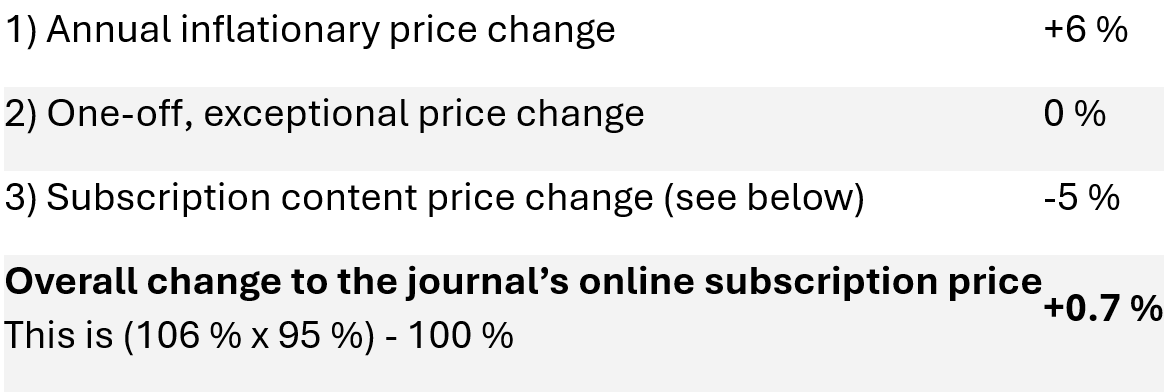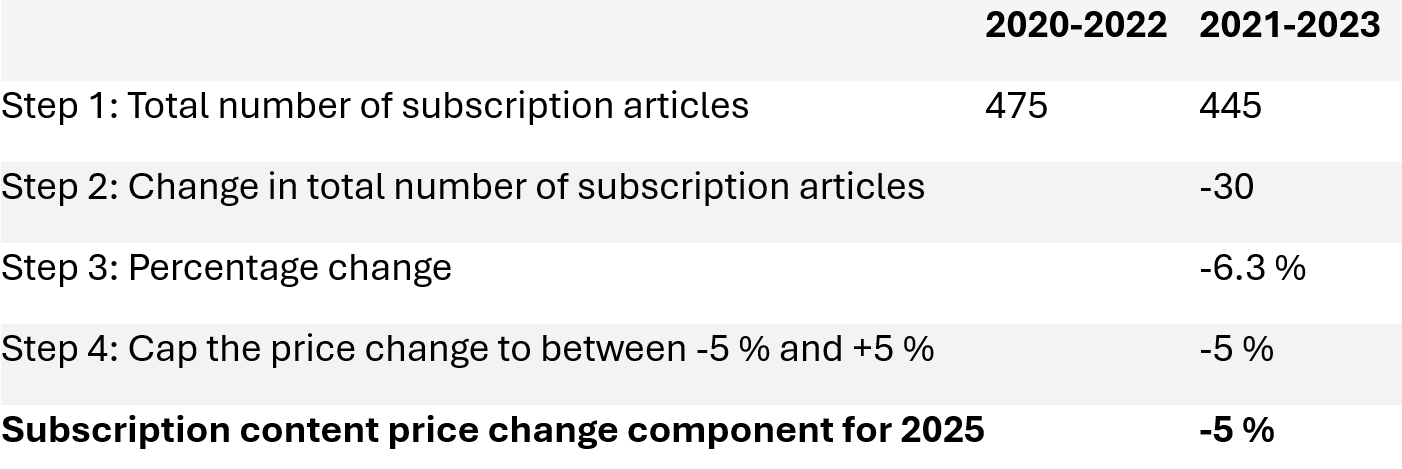Transparent pricing policy for journals
It is unfair to ‘double dip’ by charging subscribers for open access content that has received funding through an institutional open access agreement, an article processing charge (APC), the Cambridge Open Equity Initiative, sponsorship from a third party, or some other mechanism.
Our pricing policy contains up to three components:
- An inflationary increase that is applied to all journals to reflect changes to the overall cost base of our journals programme. Different increases may be applied to print and online formats.
- Occasionally, we apply a further price increase or decrease to an individual journal for exceptional reasons, for example a dramatic change in the type of content that a journal publishes.
- For online-only subscriptions, we then apply a price correction to prevent double-dipping and to reflect changes in content funded by subscription charges (that is, non-open access content and open access articles that were not funded by an APC, an institutional agreement, the Cambridge Open Equity Initiative, or other means). The price change component is usually capped to an upper and lower threshold e.g. -5% and +5%.
As we transition our journal research to fully open access, we will be conducting further reviews of our journals pricing policy to ensure we continue to operate a fair and sustainable model.
Worked example
1) Annual inflationary price change: +6 %
2) One-off, exceptional price change: 0 %
3) Subscription content price change (see below): -5 %
Overall change to the journal’s online subscription price: +0.7 %
(This is (106 % x 95 %) - 100 %)

Worked example

1) Annual inflationary price change: +6 %
2) One-off, exceptional price change: 0 %
3) Subscription content price change (see below): -5 %
Overall change to the journal’s online subscription price: +0.7 %
(This is (106 % x 95 %) - 100 %)
Changes in subscription content
The subscription content component of our pricing policy (item 3 in the above) determines how we reduce the prices for online-only subscriptions during the transition to open access.
The price change is the percentage change in the total amount of subscription content over the two most recent three-year periods. The following two examples show how article data from 2020–2023 journal volumes was used in 2024 to determine the subscription content price change applied to the online-only prices for 2025 journal volumes:
Example 1: a decrease in subscription articles
Step 1: Total number of subscription articles: 2020-2022 = 475; 2021-2023 = 445
Step 2: Change in total number of subscription articles = -30
Step 3: Percentage change = -6.3 %
Step 4: Cap the price change to between -5 % and +5 % = -5 %
Subscription content price change component for 2025 = -5 %

Example 1: a decrease in subscription articles

Step 1: Total number of subscription articles: 2020-2022 = 475; 2021-2023 = 445
Step 2: Change in total number of subscription articles = -30
Step 3: Percentage change = -6.3 %
Step 4: Cap the price change to between -5 % and +5 % = -5 %
Subscription content price change component for 2025 = -5 %
Example 2: an increase in subscription articles
Step 1: Total number of subscription articles: 2020-2022 = 475; 2021-2023 = 505
Step 2: Change in total number of subscription articles = +30
Step 3: Percentage change = +6.3 %
Step 4: Cap the price change to between -5 % and +5 % = +5 %
Subscription content price change component for 2025 = +5 %

Example 2: an increase in subscription articles

Step 1: Total number of subscription articles: 2020-2022 = 475; 2021-2023 = 505
Step 2: Change in total number of subscription articles = +30
Step 3: Percentage change = +6.3 %
Step 4: Cap the price change to between -5 % and +5 % = +5 %
Subscription content price change component for 2025 = +5 %
The price change cap and the three-year measurement period help us avoid unnecessary price changes due to transient fluctuations in the amount of subscription content a journal publishes each year.
We will monitor the price caps to ensure they remain appropriate and allow journal subscription prices to be sufficiently reduced over time in line with the transition to open research. Additional price decreases may also be applied to a journal if necessary.
Notes
- Gold OA articles that receive no open access funding are supported by journal subscriptions, and therefore these articles are counted as subscription articles in the pricing calculations.
- A few article types, particularly conference abstracts, are excluded from the calculation.
- The subscription content pricing component is only applied to online-only subscriptions. Subscriptions that include a print copy of a journal are not affected.
- In rare cases, we have pre-existing agreements with an academic society that affect our ability to fully implement the subscription content pricing component.
